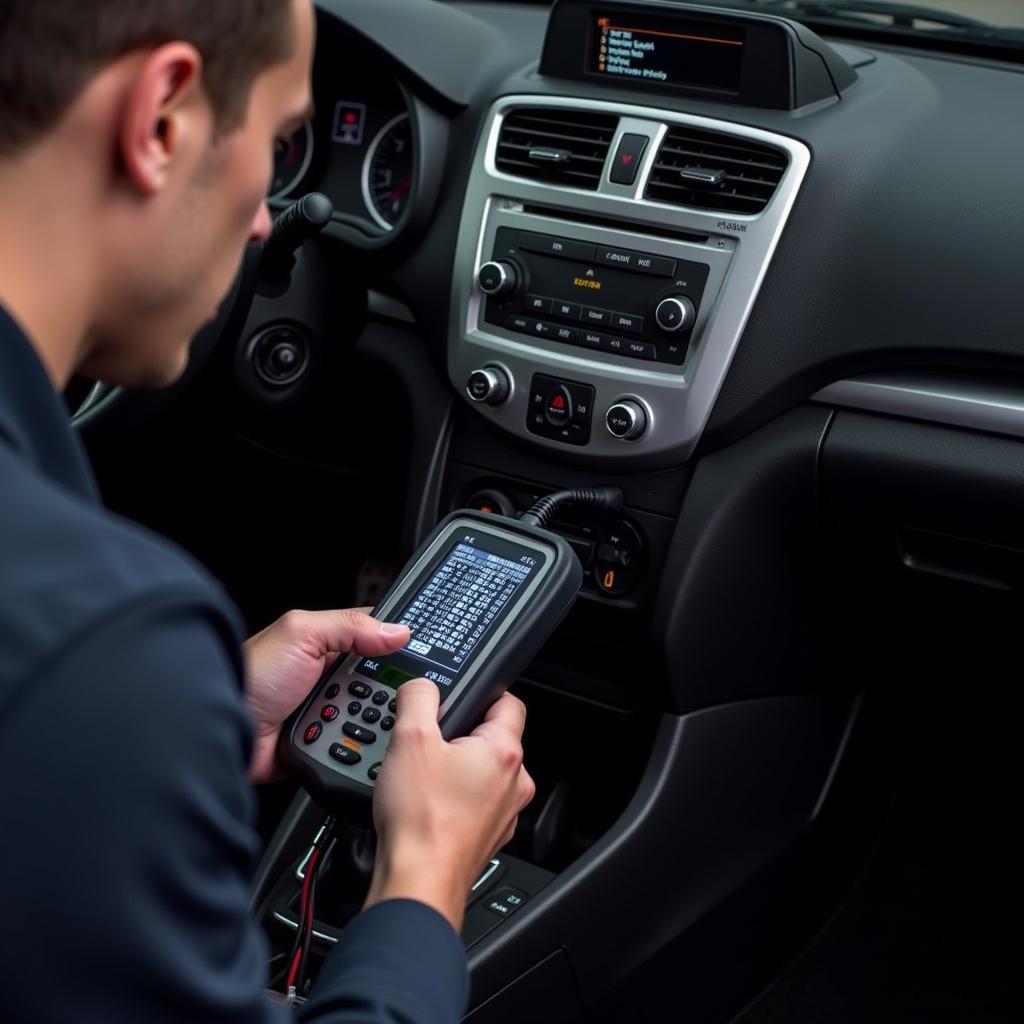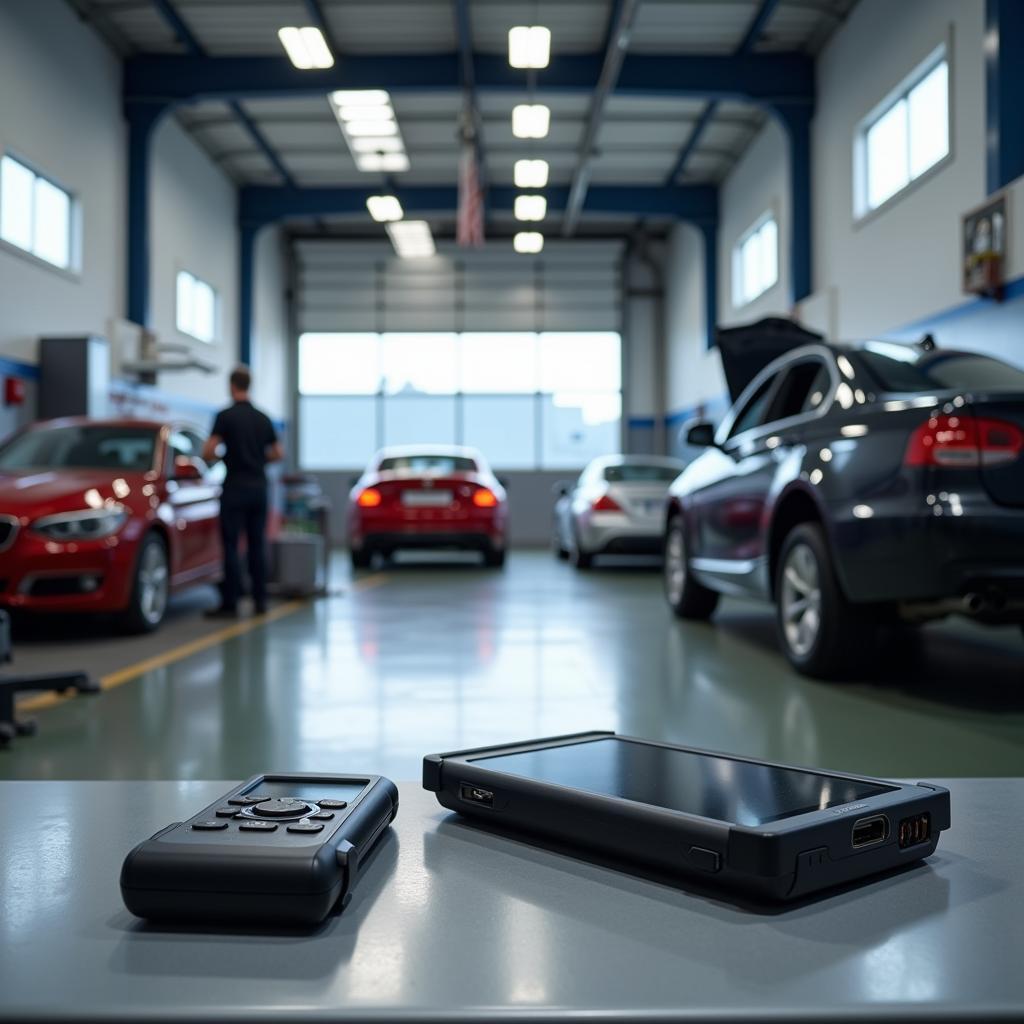A scan tool test, also known as an OBD-II scan, is a crucial procedure used to diagnose car problems. It involves retrieving data from a vehicle’s onboard computer, the Engine Control Unit (ECU), using a specialized device called a scan tool. This data provides valuable insights into the performance of various vehicle systems, helping mechanics and car owners identify and troubleshoot issues effectively.
 Mechanic connecting a scan tool to a car's OBD port
Mechanic connecting a scan tool to a car's OBD port
Understanding the Basics: How Scan Tool Tests Work
Modern vehicles are equipped with sophisticated computer systems that monitor and control a wide range of functions, from engine performance and emissions to transmission shifting and safety features. These systems generate and store diagnostic trouble codes (DTCs) whenever a malfunction is detected. A scan tool acts as a communication bridge between the vehicle’s ECU and the user, allowing access to these codes and other vital data.
When you connect a scan tool to the vehicle’s OBD-II port, it retrieves these DTCs and presents them in an understandable format. These codes, often represented by a combination of letters and numbers, indicate the specific area or system where the issue lies. For instance, a code like “P0301” typically signifies a misfire in cylinder number one.
 Mechanic analyzing scan tool data for car diagnostics
Mechanic analyzing scan tool data for car diagnostics
Beyond Codes: The Power of Data in Scan Tool Tests
While DTCs provide a starting point for diagnosis, scan tool tests offer much more than just error codes. They unlock a wealth of live data streams, including:
- Engine RPM: This indicates the engine’s speed and can help identify issues like misfires, rough idling, or low power.
- Coolant Temperature: Monitoring this parameter is crucial to prevent overheating and diagnose problems with the cooling system.
- Oxygen Sensor Readings: These readings provide insights into the air-fuel mixture, helping identify issues related to emissions and fuel economy.
- Throttle Position: This data indicates how far the throttle plate is open, aiding in diagnosing problems with the accelerator pedal, throttle body, or related components.
- Transmission Data: This includes information about gear positions, shift solenoids, and fluid temperature, helping pinpoint transmission-related issues.
By analyzing these data streams, mechanics can gain a comprehensive understanding of the vehicle’s health, pinpoint the root cause of problems, and make informed repair decisions.
Types of Scan Tools: Choosing the Right One for Your Needs
Scan tools come in a variety of types, each offering different levels of functionality and features.
- Basic Code Readers: These entry-level devices can read and clear basic DTCs. They are affordable and suitable for car owners who want to perform simple diagnostics.
- DIY Scan Tools: These offer more advanced features than basic code readers, such as live data streaming, freeze frame data, and some bi-directional control capabilities. They are ideal for DIY enthusiasts and small workshops.
- Professional Scan Tools: These high-end devices provide comprehensive diagnostic capabilities, including advanced coding, programming, and bi-directional control over various vehicle systems. They are essential for professional mechanics and dealerships.
[https www.autozone.com test-scan-and-specialty-tools gas-can AutoZone] offers a wide range of scan tools to choose from.
Common Applications of Scan Tool Tests
Scan tool tests play a vital role in numerous automotive repair and maintenance tasks:
- Diagnosing Check Engine Light: When the dreaded check engine light illuminates, a scan tool test is the first step to identify the underlying problem.
- Troubleshooting Engine Performance Issues: From misfires and rough idling to loss of power and poor fuel economy, scan tool data helps pinpoint the root cause of engine performance woes.
- Diagnosing Transmission Problems: Scan tools can read transmission codes, monitor fluid temperatures, and analyze shift patterns to diagnose transmission-related concerns.
- Verifying Repairs: After completing a repair, mechanics use scan tools to clear codes, verify system functionality, and ensure the problem is resolved.
- Performing Emissions Testing: Many states require vehicles to pass emissions tests, and scan tools are used to assess the performance of emissions-related components.
[what scan tool can also energize for testing What scan tool can also energize for testing?]
The Future of Scan Tool Tests: Embracing Technology
As vehicles become increasingly sophisticated, so too will scan tools and diagnostic techniques. The future of scan tool testing is likely to be shaped by trends such as:
- Wireless Connectivity: Wireless scan tools, communicating with smartphones or tablets via Bluetooth or Wi-Fi, offer greater convenience and mobility.
- Cloud-Based Diagnostics: Cloud-based platforms enable mechanics to access vast databases of technical information, wiring diagrams, and repair procedures, enhancing diagnostic accuracy.
- Predictive Analytics: Advanced scan tools with predictive analytics capabilities can analyze vehicle data to anticipate potential problems before they arise, enabling proactive maintenance.
Conclusion
Scan tool tests are an indispensable part of modern automotive diagnostics and repair. Understanding the basics of scan tool testing, the types of tools available, and their diverse applications can empower car owners and mechanics alike to effectively diagnose and resolve vehicle issues.
Need help diagnosing a car problem? Contact ScanToolUS today at +1 (641) 206-8880 or visit our office at 1615 S Laramie Ave, Cicero, IL 60804, USA. Our team of experts is here to assist you!
 Modern car repair shop with a scan tool in use
Modern car repair shop with a scan tool in use
FAQs about Scan Tool Tests
1. Can I use any scan tool on my car?
While most vehicles manufactured after 1996 use the standard OBD-II port, the specific protocols and data accessible can vary between makes and models. It’s crucial to choose a scan tool compatible with your vehicle’s make, model, and year.
2. Will a scan tool tell me exactly what’s wrong with my car?
Scan tools provide valuable diagnostic information but don’t always pinpoint the exact fault. They offer clues and insights that, combined with mechanical expertise and further inspection, lead to an accurate diagnosis.
3. Can I fix my car based solely on scan tool data?
While scan tools offer valuable diagnostic data, it’s not advisable to attempt repairs based solely on their readings. Proper diagnosis often requires mechanical knowledge, experience, and additional tests.
4. How often should I perform a scan tool test on my car?
It’s a good practice to perform a scan tool test annually or whenever you experience any warning lights or unusual vehicle behavior.
5. Can I use a scan tool to reset my car’s computer?
Yes, most scan tools allow you to clear diagnostic trouble codes and reset the vehicle’s computer. However, it’s essential to address the underlying problem that triggered the codes in the first place.

